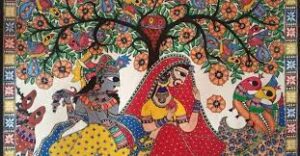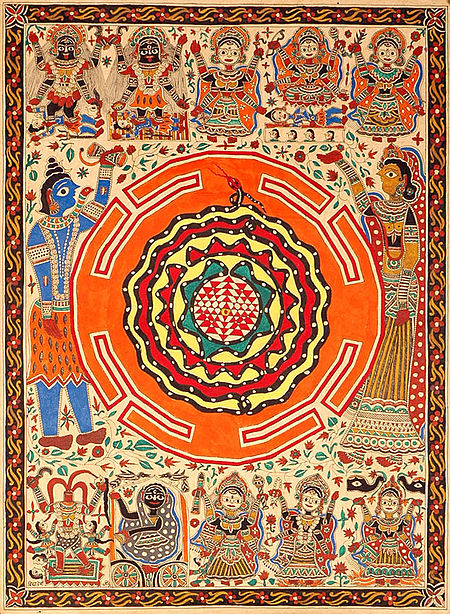Mithila painting (or Madhubani art) is a style of painting practiced in the Mithila region of India and Nepal. Artists create these paintings using a variety of mediums, including their own fingers, or twigs, brushes, nib-pens, and matchsticks. The paint is created using natural dyes and pigments. The paintings are characterised by their eye-catching geometrical patterns. There is ritual content for particular occasions, such as birth or marriage, and festivals, such as Holi, Surya Shasti, Kali Puja, Upanayana, and Durga Puja.

Madhubani painting (Mithila painting) was traditionally created by the women of various communities in the Mithila region of the Indian subcontinent. It originated from Madhubani district of the Mithila region of Bihar. Madhubani is also a major export center of these paintings. This painting as a form of wall art was practiced widely throughout the region; the more recent development of painting on paper and canvas mainly originated among the villages around Madhubani, and it is these latter developments that led to the term “Madhubani art” being used alongside “Mithila Painting.”

The paintings were traditionally done on freshly plastered mud walls and floors of huts, but now they are also done on cloth, handmade paper and canvas. Madhubani paintings are made from the paste of powdered rice. Madhubani painting has remained confined to a compact geographical area and the skills have been passed on through centuries, the content and the style have largely remained the same. Thus, Madhubani painting has received GI (Geographical Indication) status. Madhubani paintings use two-dimensional imagery, and the colors used are derived from plants. Ochre, Lampblack and Red are used for reddish-brown and black, respectively.

Madhubani paintings mostly depict people and their association with nature and scenes and deities from the ancient epics. Natural objects like the sun, the moon, and religious plants like tulsi are also widely painted, along with scenes from the royal court and social events like weddings. In this paintings generally, no space is left empty; the gaps are filled by paintings of flowers, animals, birds, and even geometric designs. Traditionally, painting was one of the skills that was passed down from generation to generation in the families of the Mithila Region, mainly by women . It is still practiced and kept alive in institutions spread across the Mithila region. Madhubanipaints By Asha jha in Darbhanga, Kalakriti in Darbhanga, Vaidehi in Madhubani, Benipatti in Madhubani district and Gram Vikas Parishad in Ranti are some of the major centres of Madhubani painting which have kept this ancient art form alive.

Madhubani art has five distinctive styles: Bharni, Katchni, Tantrik, Godna and Kohbar. In the 1960s Bharni, and Tantrik styles were mainly done by Brahman women, who are ‘upper caste’ women in India and Nepal. Their themes were mainly religious and they depicted Gods and Goddesses paintings. People of lower castes included aspects of their daily life and symbols, the story of Raja Shailesh (guard of the village) and much more, in their paintings. Nowadays Madhubani art has become a globalised art form, so there is no difference in the work on the basis of the caste system. They work in all five styles. Madhubani art has received worldwide attention.

